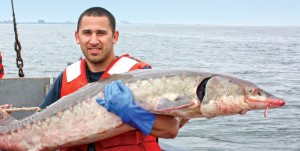Turner Fellowship Leads to Sea Change for West Coast Student
BY JOANNE MORICI
 Christopher Martinez may be a marine biologist from California, but he didn’t grow up near the ocean. Visalia, his hometown, is a small farming city in the San Joaquin Valley. His family of migrant workers traveled the West picking crops. “Because of their hard work, I was able to pursue my dream,” said Christopher, who earned his PhD in 2014.
Christopher Martinez may be a marine biologist from California, but he didn’t grow up near the ocean. Visalia, his hometown, is a small farming city in the San Joaquin Valley. His family of migrant workers traveled the West picking crops. “Because of their hard work, I was able to pursue my dream,” said Christopher, who earned his PhD in 2014.
That dream was to study biology. Animals and insects always interested Christopher, but when he made the three-and-half-hour trip to the ocean, “I was fascinated by the diversity of ocean life.”
As an undergraduate at the University of California at Santa Barbara, his passion for marine sciences solidified. Christopher became research diver certified and was listed as co-author of a study, published in 2011 in Marine Biology, for his research in French Polynesia.
When Christopher applied to the graduate program at Stony Brook, the School of Marine and Atmospheric Sciences (SoMAS) awarded him a Turner Fellowship.
The W. Burghardt Turner Fellowship helps qualified underrepresented graduate students seeking certain degrees. Since 1987, the Fellowship has graduated more than 400 degree recipients.
The Center for Inclusive Education (CIE), which provides Turner Fellowship funding, became Christopher’s second home. “The CIE offered me a support system and a sense of family,” he said. After losing outside funding, the CIE helped Christopher pay for flounder movement pattern research in Long Island bays.
Michael Frisk, associate professor in SoMAS and Christopher’s PhD advisor, helped him redirect his research. “Mike told me to design a project that truly reflected my academic interests,” said Christopher.
After studying geometric morphometrics with Distinguished Professor emeritus F. James Rohlf, Christopher pursued ecological morphology of skates and rays and spatial modeling of marine communities in the Northwest Atlantic with a grant Frisk helped him secure.
“Chris was a very bright, dedicated student,” said Frisk. “He read the literature across disciplines and developed and applied modeling methods to quantify fish communities.”
These skills helped Christopher develop his postdoctoral research proposal and earn dual fellowships with the American Museum of Natural History, where he will take advantage of the Museum’s very large fish collection.
Christopher credits much of his success to Stony Brook. “The overall level of research among faculty and graduate students at Stony Brook is really impressive,” said Christopher. “I’ve had many opportunities at Stony Brook because of its proximity to New York City, specifically the Museum of Natural History.”
via Alum Spotlight: Christopher Martinez | Stony Brook University Magazine.




